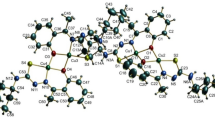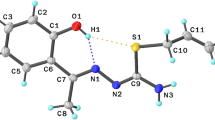Summary
Complexes of CuII, NiII, CoII, ZnII, CdII and HgII with 4-benzamido-1-o-aminoacetophenone-3-thiosemicarbazone (H2BATS) are reported and have been characterized by elemental analyses, molar conductivities, magnetic moments, spectral (visible, i.r.) and thermal (d.t.a., t.g., d.t.g.) measurements. I.r. spectra show that H2BATS behaves as a dianionic, monoanionic or neutral tetradentate ligand or as a monoanionic tridentate ligand. [Cu2(H2BATS)Cl2]·2H2O and [Cu2(H2BATS)Ac2]·2H2O complexes are diamagnetic while [Co(HBATS)OH]·2H2O and [Ni(HBATS)OH]·2H2O are octahedral. All the complexes are non-electrolytes. Generally, the solid metal acetate complexes have a unique decomposition exotherm profile which can be used as a rapid and sensitive tool for the detection of acetate-containing complexes.
Similar content being viewed by others
References
N. Orlova, V. A. Aksensova, D. A. Selidovkin and G. N. Perkin,Russ. Pharm. Toxical., 348 (1968).
D. J. Bauer, L. St. Vincent, C. H. Kempe and A. W. Dowine,Lancet,2, 494 (1963).
H. G. Petering, H. H. Buskik and G. E. Underwood,Cancer Res.,64, 367 (1964).
A. K. Srivastava, V. B. Rana and M. Mohan,J. Inorg. Nucl. Chem.,36, 2118 (1974).
V. B. Rana, S. K. Sahni, M. P. Swami, P. C. Jain and A. K. Srivastava,J. Inorg. Nucl. Chem.,38, 176 (1976).
M. M. Mostafa, A. El-Asmy and G. M. Ibrahim,Transition Met. Chem.,8, 54 (1983).
W. J. Geary,Coord. Chem. Rev.,7, 81 (1971).
F. Senti and D. Harker,J. Am. Chem. Soc.,62, 2008 (1940).
D. Hall,Acta Crystallogr.,18, 955 (1965).
C. N. R. Rao and R. Venkataraghavan,Spectrochim. Acta,18, 541 (1962).
M. Mashima,Bull. Chem. Soc. Jpn.,37, 974 (1964).
I. G. Ross and Y. Yates,Trans. Faraday Soc.,55, 1964 (1959).
E. A. Boudbeaux,Inorg. Chem.,3, 506 (1964).
P. L. Maury, B. V. Agarwala and A. K. Dey,Inorg. Nucl. Chem. Lett.,13, 145 (1977).
P. L. Maury, B. V. Agarwala and A. K. Dey,Ind. J. Chem.,16A, 358 (1978).
V. Banerjie and A. K. Dey,Makromol. Chem.,180, 2133 (1979).
C. P. Prabhakaran and C. C. Patel,Ind. J. Chem.,7, 1257 (1969).
A. K. Das and D. V. Ramana Rao,Ind. J. Chem.,13, 620 (1975).
K. Nakamoto,Infrared Spectra of Inorganic and Coordination Compounds, Wiley, New York, 1970.
D. N. Sathyanarayana and D. Nicholls,Spectrochim. Acta,34A, 263 (1978).
A. Braibanti, F. Dallvale, M. A. Pellinghell and E. Laporati,Inorg. Chem.,7, 1430 (1968).
J. R. Ferraro,Low Frequency Vibrations of Inorganic and Coordination Compounds, Plenum Press, New York, 1971.
J. R. Ferraro and W. R. Walkers,Inorg. Chem.,4, 1382 (1965).
R. J. H. Clark,J. Chem. Soc., 1377 (1963).
D. M. Adams and P. J. Lock,J. Chem. Soc. A., 620 (1967).
A. B. P. Lever,Inorganic Electronic Spectroscopy, Elsevier, 341, Amsterdam, 1968.
C. K. Jørgensen,Acta Chim. Scand.,10, 887 (1956).
Author information
Authors and Affiliations
Rights and permissions
About this article
Cite this article
Abu El-Reash, G.M., Ibrahim, K.M. & Rakha, T.H. Structural studies of 4-benzamido-1-o-aminoacetophenone-3-thiosemicarbazone complexes. Transition Met Chem 14, 209–212 (1989). https://doi.org/10.1007/BF01043797
Received:
Issue Date:
DOI: https://doi.org/10.1007/BF01043797




